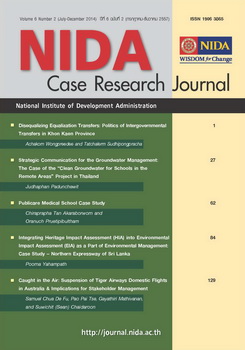Integrating Heritage Impact Assessment (HIA) into Environmental Impact Assessment (EIA) as a part of EnvironmentalManagement; case study - Northern Expressway of Sri Lanka
Keywords:
HIA (Integrating Heritage Impact Assessment) EIA into (Environmental Impact Assessment) ExpresswayAbstract
Environmental management is a growing fundamental process being implemented in the development activities of Sri Lanka. Environmental Impact Assessment (EIA) is a major technical tool used to identify and propose mitigation measures to prevent/minimize impacts to environment in order to have a sustainable development.By National Environment Act (NEA) was in 1980 recommended the adoption of EIA for development projects and from 1988 EIA was made mandatory for projects with a significant environmental impact. The types of projects that need EIA were listed under prescribed 31 categories of projects. In addition, all industrial projects that are to be located close to environmental, archaeological or culturally sensitive areas require assessment. The evaluation of EIA was delegated government project-approving agencies (PAA) and, with concurrence with the Central Environmental Authority (CEA), via standard process that decided the final approval of the development project.
A new expressway called Northern Expressway Project (NEP) will be constructed by the Roads Development Authority (RDA) of the Government of Sri Lanka connecting Colombo capital and Northern and Eastern provinces, under two phases. Phase one has four stages, Enderamulla to Meerigama 42 km; Meerigama to Kurunegala 39 km; Expressway link to Kandy 46 km and Kurunegala to Dambulla 63 km. As per the NEA this project was categorized as a prescribed project and the CEA has requested RDA to carrying out an EIA. Heritage Impact Assessment (HIA) has formulated and conducted by the author to integrate archaeological, historical and cultural heritage intended impacts and propose possible mitigation measures as a part of EIA of the project. Identification of heritage properties and attributes, mapping, describing possible impacts and propose appropriate mitigation measures are key objectives of the HIA. Literature survey, PRA tools, Direct observations and Field surveys were implemented methods to fulfil the assessment. Following are some of the outputs; Stage I & II – 20, Stage III – 21 and Stage IV – 26 heritage properties with their attributes was identified and proposed 23 mitigation measures to prevent/minimize impacts to already identified archaeological, historical and cultural heritage properties. Detail heritage assessment was conducted for each of the heritage property.
Finally, it was recommended to integrate HIA for each and every EIA in-order to have sustainable environmental management and development.
Downloads
How to Cite
Yahampath, P. (2014). Integrating Heritage Impact Assessment (HIA) into Environmental Impact Assessment (EIA) as a part of EnvironmentalManagement; case study - Northern Expressway of Sri Lanka. NIDA Case Research Journal, 6(2), 86–130. retrieved from https://so04.tci-thaijo.org/index.php/NCRJ/article/view/27679
Issue
Section
Case Study





